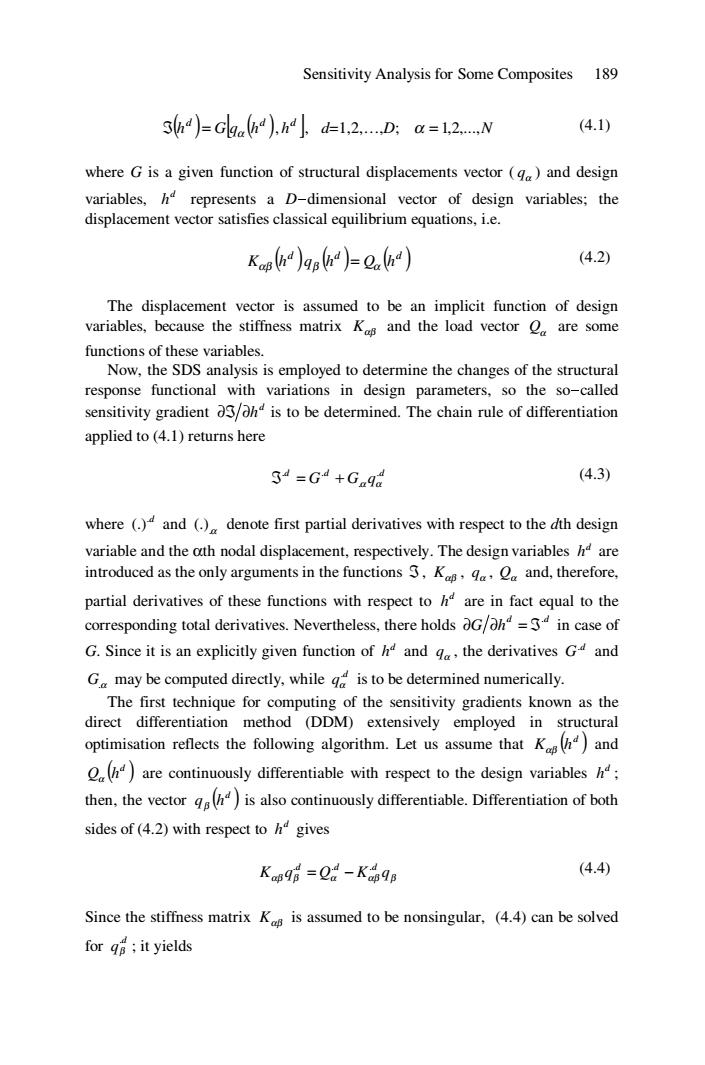正在加载图片...

Sensitivity Analysis for Some Composites 189 (hd)=Gga(hd),hd.d=1.2.....D:a=1.2....N (4.1) where G is a given function of structural displacements vector (g)and design variables,h represents a D-dimensional vector of design variables;the displacement vector satisfies classical equilibrium equations,i.e. Keke)galh)=Q.e) (4.2) The displacement vector is assumed to be an implicit function of design variables,because the stiffness matrix K and the load vector o are some functions of these variables. Now,the SDS analysis is employed to determine the changes of the structural response functional with variations in design parameters,so the so-called sensitivity gradient 03/oh"is to be determined.The chain rule of differentiation applied to(4.1)returns here 34=G4+G.9a (4.3) where (.)and (.denote first partial derivatives with respect to the dth design variable and the ath nodal displacement,respectively.The design variables hare introduced as the only arguments in the functions K and,therefore, partial derivatives of these functions with respect to h are in fact equal to the corresponding total derivatives.Nevertheless,there holds 0G/oh=in case of G.Since it is an explicitly given function of h and the derivatives G and G may be computed directly,while is to be determined numerically. The first technique for computing of the sensitivity gradients known as the direct differentiation method (DDM)extensively employed in structural optimisation reflects the following algorithm.Let us assume that K and are continuously differentiable with respect to the design variablesh; then,the vector is also continuously differentiable.Differentiation of both sides of(4.2)with respect to ha gives Ko898 Qa -KoB9B (4.4) Since the stiffness matrix K is assumed to be nonsingular,(4.4)can be solved for it yieldsSensitivity Analysis for Some Composites 189 ( ) [ ( ) ] d d d ℑ h = G qα h , h , d=1,2,…,D; α = 1,2,...,N (4.1) where G is a given function of structural displacements vector ( α q ) and design variables, d h represents a D-dimensional vector of design variables; the displacement vector satisfies classical equilibrium equations, i.e. ( ) ( ) ( ) d d d Kαβ h qβ h = Qα h (4.2) The displacement vector is assumed to be an implicit function of design variables, because the stiffness matrix Kαβ and the load vector Qα are some functions of these variables. Now, the SDS analysis is employed to determine the changes of the structural response functional with variations in design parameters, so the so-called sensitivity gradient d ∂ℑ ∂h is to be determined. The chain rule of differentiation applied to (4.1) returns here d d d G G q. . . . ℑ = + α α (4.3) where .d (.) and .α (.) denote first partial derivatives with respect to the dth design variable and the αth nodal displacement, respectively. The design variables d h are introduced as the only arguments in the functions ℑ, Kαβ , qα , Qα and, therefore, partial derivatives of these functions with respect to d h are in fact equal to the corresponding total derivatives. Nevertheless, there holds d d G h . ∂ ∂ = ℑ in case of G. Since it is an explicitly given function of d h and qα , the derivatives d G. and G.α may be computed directly, while d q. α is to be determined numerically. The first technique for computing of the sensitivity gradients known as the direct differentiation method (DDM) extensively employed in structural optimisation reflects the following algorithm. Let us assume that ( ) d Kαβ h and ( ) d Q h α are continuously differentiable with respect to the design variables d h ; then, the vector ( ) d qβ h is also continuously differentiable. Differentiation of both sides of (4.2) with respect to d h gives Kαβ qβ Qα Kαβ qβ .d .d .d = − (4.4) Since the stiffness matrix Kαβ is assumed to be nonsingular, (4.4) can be solved for d q. β ; it yields